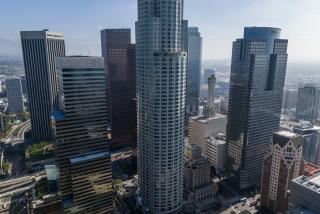In towering need of repair
The Watts Towers may be a unique and symbolically rich work of folk art, but it is also a world-class money trap, vulnerable to earthquakes and the elements, and constantly in need of repair.
There’s been long-simmering discontent among some of the most intense admirers of Simon Rodia’s 100-foot-tall structure who say the city doesn’t spend nearly enough on its upkeep and criticize the quality of conservation work carried out by L.A.’s Department of Cultural Affairs.
That criticism led to a two-hour state-of-the-towers meeting Thursday at City Hall, as two city commissions considered what has been done and what might be done to preserve them. By the end, they had resolved to try to ignite the major philanthropic effort it would take to put the towers in prime condition and enhance their value as an educational resource, an object of community pride and a tourist attraction.
The Cultural Affairs Commission, which advises on arts policy, and the Cultural Heritage Commission, which oversees landmarks, voted unanimously to send a letter to Mayor Antonio Villaraigosa, asking him to help recruit donors and activists for a private, nonprofit support group akin to ones that help fund the Los Angeles Zoo and Griffith Park Observatory.
It could take about $5 million to restore Rodia’s fantasia of cement and steel to prime condition, according to one “quick and dirty” estimate, said Olga Garay, executive director of the cultural affairs department. But straitened finances recently brought the layoff of three city workers who did the conservation work, along with an office assistant assigned to the project, Garay said. That leaves a curator and one technician devoted to the towers, as annual spending on upkeep drops from about $300,000 to $200,000.
The Committee for Simon Rodia’s Towers in Watts, which helped save the towers from the wrecking ball in the late 1950s, has long been frustrated by the city’s efforts. The citizens’ group argues that what maintenance the city does provide suffers from improper methods and materials that distort or damage some of Rodia’s ornamental flourishes.
Rodia, an uneducated Italian immigrant stonemason, labored on the towers alone for more than 30 years, starting in 1921, creating a triple-spired skeleton of steel and wire, fleshing it out with concrete and adorning its surfaces with colorful bits of glass, pottery, tile and seashells.
“The Watts Towers is a symbol of how one can be thought of as being nothing, and be able to do something,” towers activist Rudy Barbee told commissioners. It needs to be preserved, he said, as an object lesson to young Angelenos that “you can do the same.”
One man may have made the towers, but stopping nature from unmaking them could depend on mustering a cooperative effort to fund its future. The Towers in Watts committee, which donated it to the city in 1975, has been at frequent loggerheads with officials over the last nine years.
In defense of what her department has done, Garay noted that consultants hired by the state parks department to study the towers’ condition and conservation techniques gave the city passing grades three years ago, finding that its work was “consistent with generally accepted standards.”
But she acknowledged that of 10 recommendations made by the consultants, Architectural Resources Group, just one has been fully implemented, another has been partly accomplished and the rest have gone unaddressed due to budget restrictions -- including testing new materials to see whether they might be more effective in mending cracks than the epoxy that’s being used.
Garay said she has been in contact with the Getty Conservation Institute, a branch of the J. Paul Getty Trust that funds and lends expertise to art conservation projects around the world, and the Los Angeles County Museum of Art, whose director, Michael Govan, prizes the towers.
“We’re very early in the exploratory stages, but my hope is that civic pride will lead . . . these two gigantic entities to join forces with the city,” Garay said.
Overall, she said, $6.2 million has been spent on the towers’ upkeep since 1991 -- about $3 million each from the city and the state, and $155,000 in grants from private foundations.
“We have to start thinking out of the box, because this is a huge undertaking,” said Oz Scott, a cultural heritage commissioner.
--
mike. boehm@latimes.com
More to Read
Sign up for Essential California
The most important California stories and recommendations in your inbox every morning.
You may occasionally receive promotional content from the Los Angeles Times.











